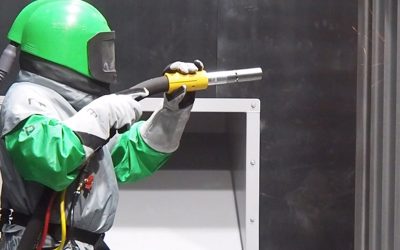Does Sandblasting Remove Rust?
Sandblasting is a popular process for cleaning or surface finishing that utilizes compressed air to create a jet of small-particle media (like sand). While it’s a versatile method to roughen or clean a surface, sandblasting isn’t right for every application. The high pressure makes it an ideal process to remove even the toughest imperfections , but many still wonder about its viability removing rust. Sandblasting is a very effective method for removing rust, since the media blast can break the corrosion away from the metal surface. However, there are a number of things to keep in mind when using this process to eliminate something as pesky as rust.
How Does the Process Work?
Sandblasting works by using the air compressor to create a powerful stream of abrasive media. The pressure from the compressor combines the high-velocity air stream with the abrasive grains of the sand or other media. The high speeds help break down the rust and remove it. When removing rust with this process, it’s important to make sure to maintain proper pressure or it can wind up damaging the underlying metal. Too much pressure, or extended exposure to that pressure can warp the metal due to the heat created in the process.
Taking the necessary precautions is also important when sandblasting rust. Using proper protective equipment is essential since sand contains high amounts of silica. This can life-threatening health complications, like cancer or silicosis, if too much inhaled . Wearing protective goggles, fully enclosed respirator helmet to filter particulate and dust (known as a blast/sandblast helmet), and other protective equipment are precautions that must be taken for any sandblasting project. Other forms of media can be safer, but it’s important to take all necessary precautions – and to know the media you’re using.
Choosing the Right Media for Sandblasting
Sandblasting is also known as abrasive blasting, because there are a variety of other media that can be used through the process. Sand is becoming less common in these applications, mainly due to some of the health issues listed above. The right media can also eliminate some of the concern for damaging the metal. For example, using a soda abrasive made from baking soda or a soda bicarbonate can help remove rust without damaging the metal as it has a much gentler cleaning action. However, soda bicardonate wouldn’t be suited to heavy corrosion, just lighter processing.
Aluminum oxide is also a great choice for rust removal, as it’s one of the kindest media around. This isn’t ideal for heavy projects, but the gentle nature of aluminum oxide is perfect for removing thin layers of rust. For removing thicker coats of rust on ferrous surfaces, stainless steel abrasive would be better suited for that application. Stainless steel is exceptionally efficient for large areas, and is more cost-effective than some of the other media as it is reclaimable and can be used more than once.
Sandblasting/abrasive blasting is a great way to remove rust while preserving the metal underneath. For more information on sandblasting, all of the benefits of the process, and how the process works, reach out to the experts at Airblast AFC today.




